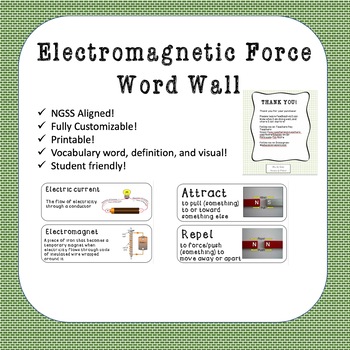Electromagnetic Force Word Wall NGSS 6-8 Aligned | Fully Editable and Printable
- PPTX
Description
This complete Electromagnetic Force Word Wall contains full scholar friendly vocabulary words with definitions and visual. Because this is a PowerPoint is is fully customizable and it includes template to add your own words, over 20 pages of vocabulary! Perfect for grades 5-12.
NGSS Standard Alignment:
MS-PS2-1 Motion and Stability: Forces and Interactions
Apply Newton’s Third Law to design a solution to a problem involving the motion of two colliding objects.*
MS-PS2-2 Motion and Stability: Forces and Interactions
Plan an investigation to provide evidence that the change in an object’s motion depends on the sum of the forces on the object and the mass of the object.
MS-PS2-3 Motion and Stability: Forces and Interactions
Ask questions about data to determine the factors that affect the strength of electric and magnetic forces.
MS-PS2-4 Motion and Stability: Forces and Interactions
Construct and present arguments using evidence to support the claim that gravitational interactions are attractive and depend on the masses of interacting objects.
MS-PS2-5 Motion and Stability: Forces and Interactions
Conduct an investigation and evaluate the experimental design to provide evidence that fields exist between objects exerting forces on each other even though the objects are not in contact.
Construct and interpret graphical displays of data to describe the relationships of kinetic energy to the mass of an object and to the speed of an object.
Develop a model to describe that when the arrangement of objects interacting at a distance changes, different amounts of potential energy are stored in the system.





